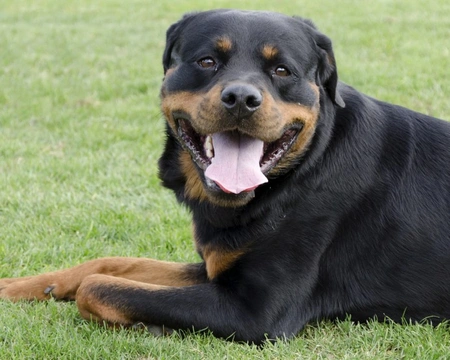
Five skin and coat problems that can irritate your Rottweiler
The Rottweiler is a large, stocky and muscular dog that is very loving and loyal, and who likes nothing more than to flump out in front of the sofa with their family, despite the breed’s somewhat fearsome reputation thanks to their skills as guard dogs and watch dogs.
There is a lot to be said about the Rottweiler as a good family pet and all-rounder, and they tend to be slow-moving, calm dogs that don’t get rattled easily and take most things in their stride – but like all pedigree dog breeds, the Rottweiler breed as a whole has elevated risk factors for certain hereditary health conditions that can affect their health and quality of life.
The main health concerns across the Rottweiler breed as a whole include hip and elbow dysplasia – but the breed also tends to be rather more prone to skin and coat problems than others too, which is something that all Rottweiler owners and potential Rottweiler puppy buyers should be aware of.
In this article, we will look at five of the most common skin and coat problems that can affect the Rottweiler, and what to do about them. Read on to learn more.
Eczema
Eczema is of course a chronic skin condition that affects humans as well as dogs, and that can potentially be itchy and irritating. Eczema can cause your dog’s skin to become sore and inflamed, and feel tight and uncomfortable, as well as leading to pustules and raised lumps that may weep or become sore.
Over time, the thickness and texture of the skin can change too, and develop pigmented patches. Dogs with eczema will sometimes lose patches of fur, and suffer from visible dandruff.
If you know or suspect that your Rottweiler has eczema, you should ask your vet to check them out and make a formal diagnosis as soon as possible. Treating and managing the condition may involve treating any soreness or damage to the skin itself and limiting further damage, keeping the dog comfortable, and if necessary, running tests to ascertain if the condition is immune-mediated, and requires supportive therapies to reduce flare-ups.
Folliculitis
Folliculitis or follicular infections are infections that develop in the dog’s hair follicles, which you may have to look for closely to spot. Follicular infections can look a little like an ingrown hair – a little spot or pustule in the hair follicle, with a visible hair within it or growing from it. These usually develop in patches or clusters, most commonly in the armpits and groin.
However, a follicular infection or folliculitis is more acute than a simple ingrown hair, and over time, the infection can develop more deeply under the surface of the skin and lead to abscesses and boils. These will make your dog feel rather miserable and under the weather, and may burst and seep a foul-smelling pus.
You may not know for sure why your Rottweiler might develop folliculitis, but it is a common secondary complication of other skin conditions and damage to the skin too, which makes the Rottweiler rather more prone to it than most breeds.
Again, ask your vet to examine the problem and determine an appropriate treatment protocol.
Allergies
Dogs of all breeds and types may potentially suffer from allergies, but the Rottweiler again seems to get more than their fair share of them! Food allergies can lead to skin and coat symptoms and so feeding your dog the right diet that takes into account this sensitivity (if relevant) is important, but the breed is also rather more prone to allergies that affect the coat than most other breeds.
Contact allergies, which may be seasonal or localised, can lead to itchy, inflamed and sore patches developing across your dog’s coat, which are likely to cause your dog to scratch and bother at their skin a lot, and so, increase the damage and lead to the added risk of infection.
You will need to work with your vet to determine the triggers of your dog’s allergy, or to minimise the effect that it has on them, and to reduce the severity and frequency of flare-ups.
Dermatitis
Dermatitis is a catch-all term used to refer to a range of different issues that lead to inflamed and sore or irritated skin that develops without a rash or clear pattern. This will make your dog uncomfortable and over time, will affect their quality of life, as well as potentially worsening to affect the texture, condition and resilience of the skin itself.
Speak to your vet about managing dermatitis, and steps that you can take to make your dog comfortable and reduce the impact of the condition.
Seborrhoea
Seborrhoea is a skin condition that can lead to heavy amounts of dandruff in the coat, as well as a tacky or greasy feeling to the skin and coat.
The condition develops due to hyper-productivity of the sebaceous glands, causing them to overproduce the sebaceous substance that helps to lubricate and protect the skin and coat.
As the condition is generally hereditary, it is a good idea to find out as much as you can about your Rottweiler’s parents and ancestry, in order to determine their risk factors. Treating the condition is largely concerned with managing and controlling it, which usually involves bathing and cleansing the skin with appropriate products, and potentially, using topical medications to ease the symptoms.



